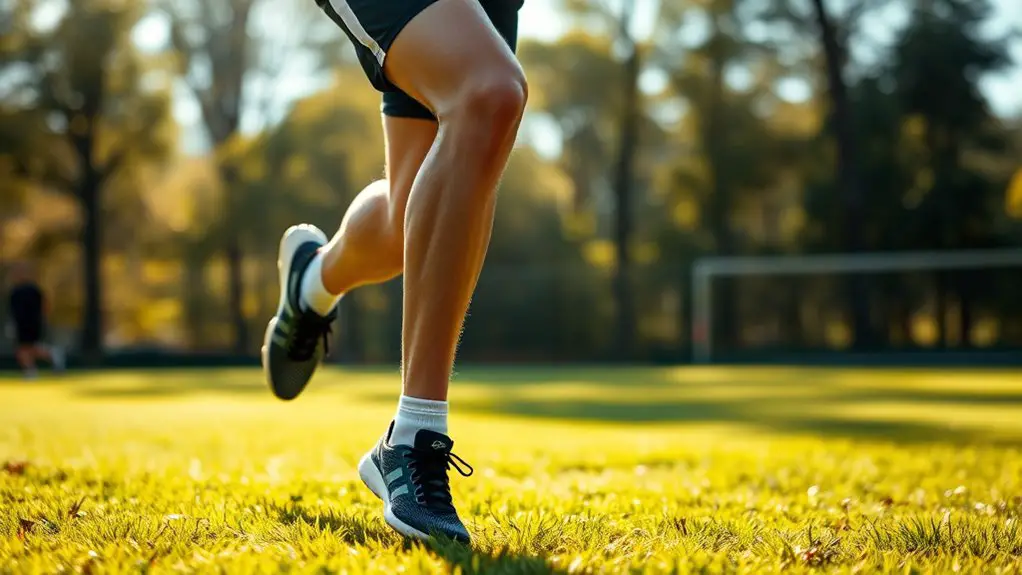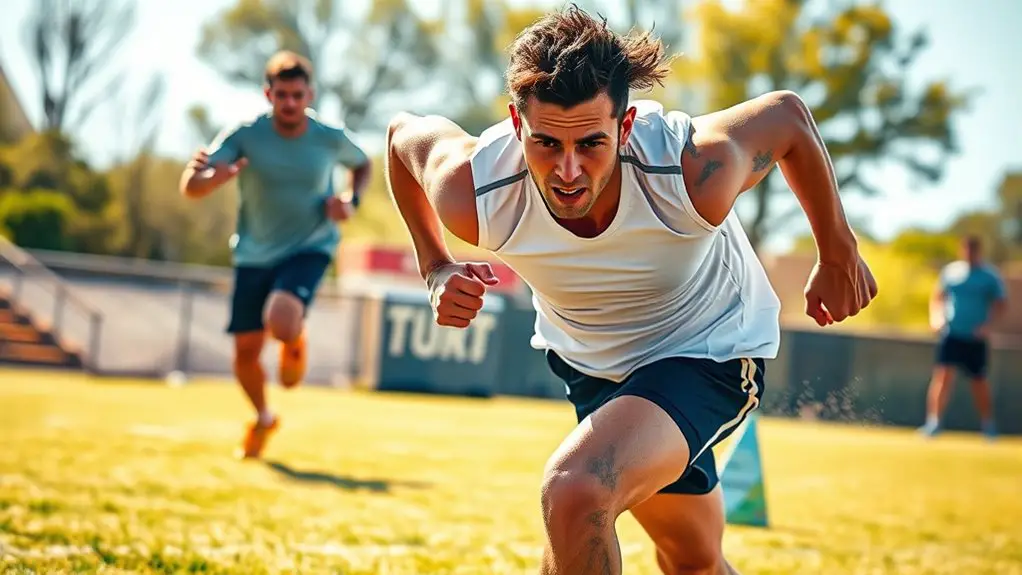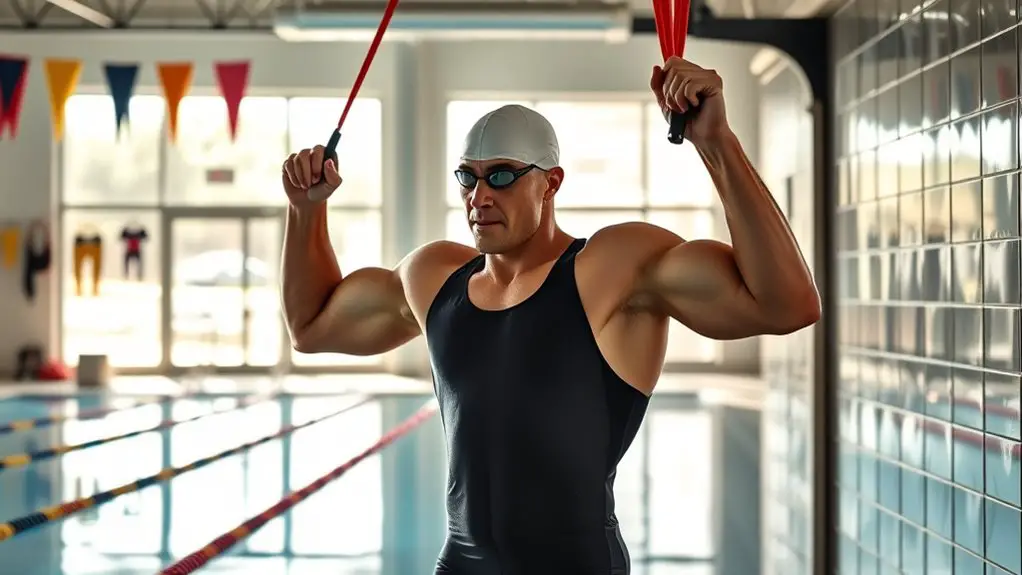Strengthening your legs is key to improving footwork and overall movement. Focus on essential muscles like quadriceps, hamstrings, calves, and glutes through exercises such as squats, lunges, and deadlifts. Incorporating plyometrics like box jumps can boost your explosive power and agility. Aim for 2-3 leg workouts a week, allowing for recovery. Prioritize form to avoid injury and maximize gains. Keep practicing, and you'll discover even more ways to elevate your performance.
Understanding the Importance of Leg Strength
When you think about improving your footwork, it's easy to overlook the role of leg strength, but it's essential for agility and balance. Strong legs empower you to move freely, enhancing your athletic performance in any sport. When you build leg strength, you're not just boosting your endurance; you're also increasing your ability to change direction quickly and maintain stability. This strength translates into faster reactions and smoother movements, allowing you to express your physicality without hesitation.
Whether you're sprinting down the field, making sharp cuts on the court, or simply enjoying a run, strong legs contribute greatly to your overall mobility. Plus, with improved leg strength, you'll feel more confident in your movements, giving you the freedom to push your limits. So, prioritize leg strength training in your routine, and watch how it elevates your footwork and overall performance. Incorporating squats and lunges into your workouts can significantly enhance your strength and stability on the court.
Key Muscle Groups Involved in Leg Movement
Leg movement relies heavily on several key muscle groups that work together to create power and stability. Your quadriceps function as the main drivers for extending your knee, allowing for explosive movements. Don't underestimate the hamstring's importance; they balance out the quadriceps, helping with knee flexion and stability during dynamic actions. The calf muscles contribute considerably to ankle stability, critical for maintaining balance and control as you move.
Glute engagement is essential, providing strength for hip extension and supporting your overall lower body power. Hip flexors allow you to lift your legs and change direction swiftly, enhancing your agility. All these muscle groups work in harmony, ensuring muscle coordination and joint mobility, which are fundamental for fluid movement. By incorporating glute activation exercises, you're one step closer to achieving freedom in your footwork and enhancing your overall movement efficiency.
Essential Leg Exercises for All Levels
To build a solid foundation for your footwork, incorporating essential leg exercises into your routine is crucial. Whether you're a beginner or more advanced, these exercises will enhance your strength and agility. Bodyweight exercises improve muscle endurance and coordination, which are vital for effective movement in sports.
| Exercise | Description | Level |
|---|---|---|
| Bodyweight Squats | Stand with feet shoulder-width apart, squat down as if sitting. | All Levels |
| Lunges | Step forward, lowering your hips until both knees are bent. | All Levels |
| Calf Raises | Stand on the edge of a step, rise on your toes, then lower. | All Levels |
| Resistance Training | Use bands or weights to increase strength during leg workouts. | Intermediate+ |
Incorporating these exercises will not only improve your leg strength but also your footwork. Make sure to listen to your body and adjust the intensity to find your freedom in movement.
Incorporating Plyometrics for Explosive Power
Plyometric training can greatly boost your explosive power, enhancing your footwork and overall performance. By incorporating effective plyometric exercises, you'll not only build strength but also improve your agility and speed. Let's explore the benefits and some key exercises that can take your training to the next level. Additionally, plyometrics focuses on improving the stretch-shortening cycle of muscles, allowing for maximum potential in athletic movements.
Benefits of Plyometric Training
When you're looking to enhance your footwork, incorporating plyometric training can be a game-changer. The plyometric benefits are numerous and can greatly improve your athletic performance. By focusing on explosive training, you'll develop quickness and agility, allowing you to move freely and confidently.
Here are some key benefits:
- Increased power: Boosts your strength for explosive movements.
- Enhanced coordination: Improves your overall body control.
- Faster reaction times: Helps you respond quickly in dynamic situations.
- Improved balance: Strengthens your stability during movement.
- Injury prevention: Builds muscle resilience to reduce injury risk.
Effective Plyometric Exercises
While you're working on your explosive power, incorporating effective plyometric exercises into your training routine can take your footwork to the next level. Start with jump training, like box jumps, to build strength and heighten your agility. You can also add depth jumps, which help improve your reaction time and explosiveness. Don't forget about agility drills; lateral bounds and single-leg hops can enhance your coordination and stability. These exercises not only boost your leg strength but also help you move fluidly on the court or field. By integrating these plyometric routines, you'll develop the quickness and power needed for dynamic movement, allowing you to express your athleticism and enjoy your freedom in every performance.
The Role of Flexibility in Leg Strength
Flexibility plays an essential role in leg strength, as it allows your muscles to operate more efficiently and effectively. When you're flexible, you can move more freely, which translates to better footwork and agility. Incorporating stretching routines into your training can reveal numerous flexibility benefits, making your workouts more productive.
- Enhances range of motion in joints
- Reduces risk of injury during intense activities
- Improves muscle coordination and balance
- Aids in quicker recovery post-exercise
- Boosts overall athletic performance
To enjoy these flexibility benefits, dedicate time to include dynamic stretches before workouts and static stretches afterward. Remember, flexibility isn't just about being limber; it's about empowering your legs to perform at their best. Embrace these stretching routines, and you'll notice how much more freedom you have in your movements, paving the way for enhanced strength and agility in your legs. Moreover, improved range of motion can facilitate efficient movement patterns, further enhancing your performance.
Tips for Maintaining Proper Form During Workouts
Maintaining proper form during workouts is essential for maximizing your leg strength and preventing injuries. To achieve this, focus on your body's alignment. Keep your knees aligned with your toes during squats and lunges, avoiding any inward collapse. This simple adjustment can make a huge difference in your performance and safety.
Core engagement is just as vital—your core muscles stabilize your entire body. Before you start any leg exercises, take a moment to tighten your abdominal muscles and maintain that tension throughout your movements. This will not only support your lower back but also enhance your balance and control.
Lastly, don't rush your movements. Slow, deliberate reps allow you to focus on your form, ensuring you're fully benefiting from each exercise. By prioritizing proper alignment and core engagement, you'll empower yourself to move freely and confidently while building stronger legs. Incorporating compound movements into your routine can further enhance your overall strength and functionality.
Creating a Balanced Leg Workout Routine
To create a balanced leg workout routine, you'll want to focus on essential leg exercises that target all muscle groups. It's also important to contemplate how often you should be working out to maximize your strength and agility. Let's explore the key exercises and frequency guidelines that will help you achieve your goals. Incorporating plyometric exercises into your routine will enhance explosiveness and improve overall leg power.
Essential Leg Exercises
While a strong upper body is important, your legs play an essential role in overall athletic performance, especially when it comes to footwork. To enhance your leg endurance and support muscle recovery, it's vital to incorporate a variety of exercises into your routine. Here are some essential leg exercises that can help you achieve that balance:
- Squats: Build strength and stability.
- Lunges: Improve flexibility and coordination.
- Deadlifts: Target multiple muscle groups for overall power.
- Calf Raises: Strengthen lower legs for better agility.
- Leg Press: Enhance overall leg strength and endurance.
Workout Frequency Guidelines
Incorporating a variety of leg exercises into your routine is only part of the equation; how often you work out your legs is just as important for maximizing your performance. Aim for 2-3 leg workouts per week, ensuring you allow adequate recovery time between sessions. This balance helps prevent injury and promotes muscle growth.
Here's a simple guideline for structuring your leg workouts:
| Workout Days | Duration | Recovery Time |
|---|---|---|
| 1 | 45-60 min | 48 hours |
| 2 | 60-75 min | 48-72 hours |
| 3 | 75-90 min | 72 hours |
| Active Rest | N/A | 1-2 days |
Frequently Asked Questions
How Long Does It Take to See Improvements in Leg Strength?
When you're looking to see improvements in leg strength, it often depends on your starting point and consistency. Typically, you might notice some progress within a few weeks, but significant strength benchmarks usually take about six to eight weeks to achieve. Remember, everyone's progress timeline can vary, so it's important to stay committed and patient. Embrace the journey, and you'll find that freedom in movement becomes more attainable with each step forward.
Can Leg Strength Impact My Overall Athletic Performance?
Think of an eagle soaring effortlessly through the sky. That's what leg strength can do for your athletic performance. It's not just about leg power; it directly enhances your overall agility, letting you move with grace and speed. When you've got strong legs, you'll notice you can pivot, sprint, and jump with more ease. So, if you want to feel that freedom in your game, boosting your leg strength is essential.
What Should I Eat to Support Leg Strength Training?
To support your leg strength training, focus on quality nutrition. Incorporate lean protein sources like chicken, fish, or plant-based options to help muscle recovery and growth. Don't forget about carbohydrate timing; consuming carbs around your workouts can fuel your performance and replenish energy afterward. This way, you'll feel freer and more energized during your training. Enjoy your meals, and remember, what you eat can make a significant difference in your progress!
Are There Any Risks of Overtraining My Legs?
You know, pushing yourself too hard can feel like running a marathon in flip-flops. Overtraining your legs comes with symptoms like chronic fatigue, persistent soreness, and decreased performance. It's vital to listen to your body and recognize these signs. Recovery strategies like proper rest, hydration, and balanced nutrition are key to avoiding burnout. Freedom in your training comes from respecting your limits, so take care of those legs and they'll serve you well!
How Often Should I Train My Legs Each Week?
When considering leg training frequency, aim for about two to three sessions a week. This allows you to challenge your muscles while giving them time for workout recovery. Listen to your body; if you're feeling fatigued or sore, it's okay to take an extra rest day. Freedom in your training means finding a balance that works for you, ensuring you stay energized and ready for your next workout adventure without overdoing it.




